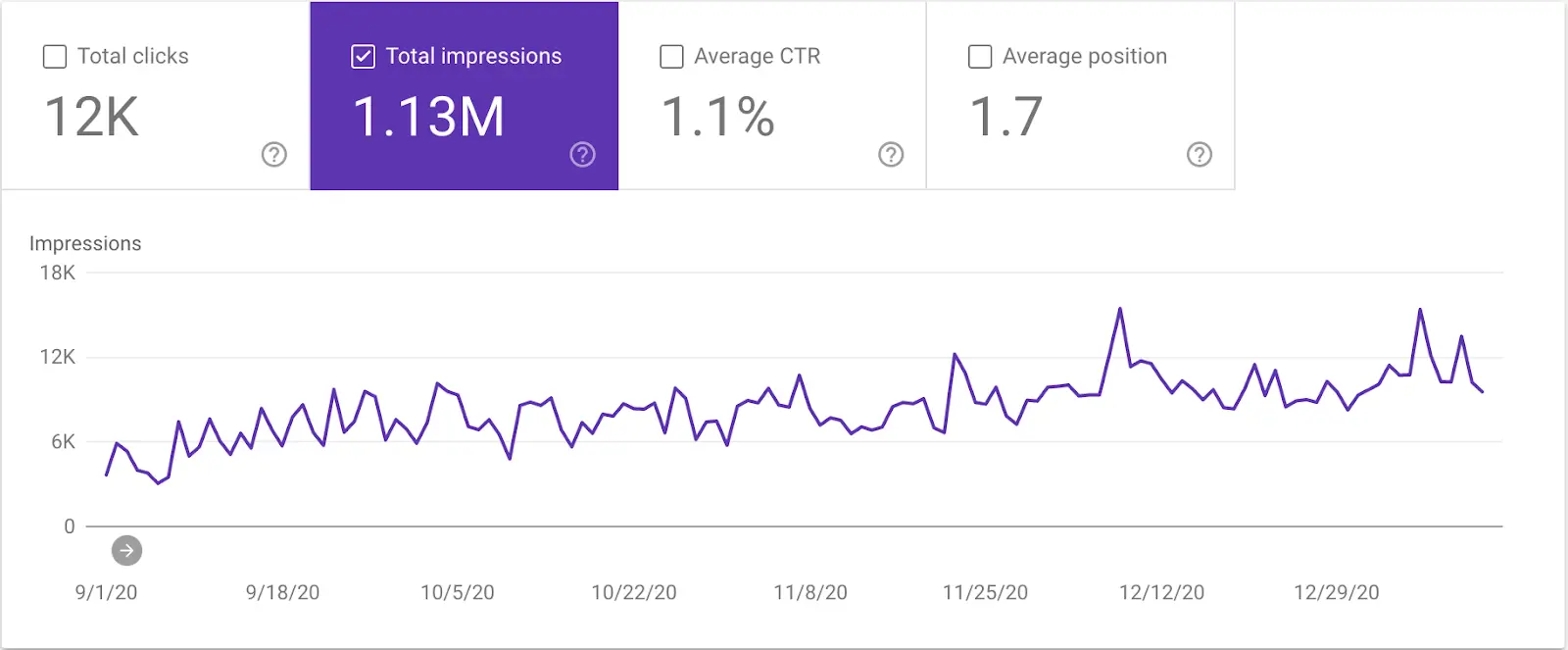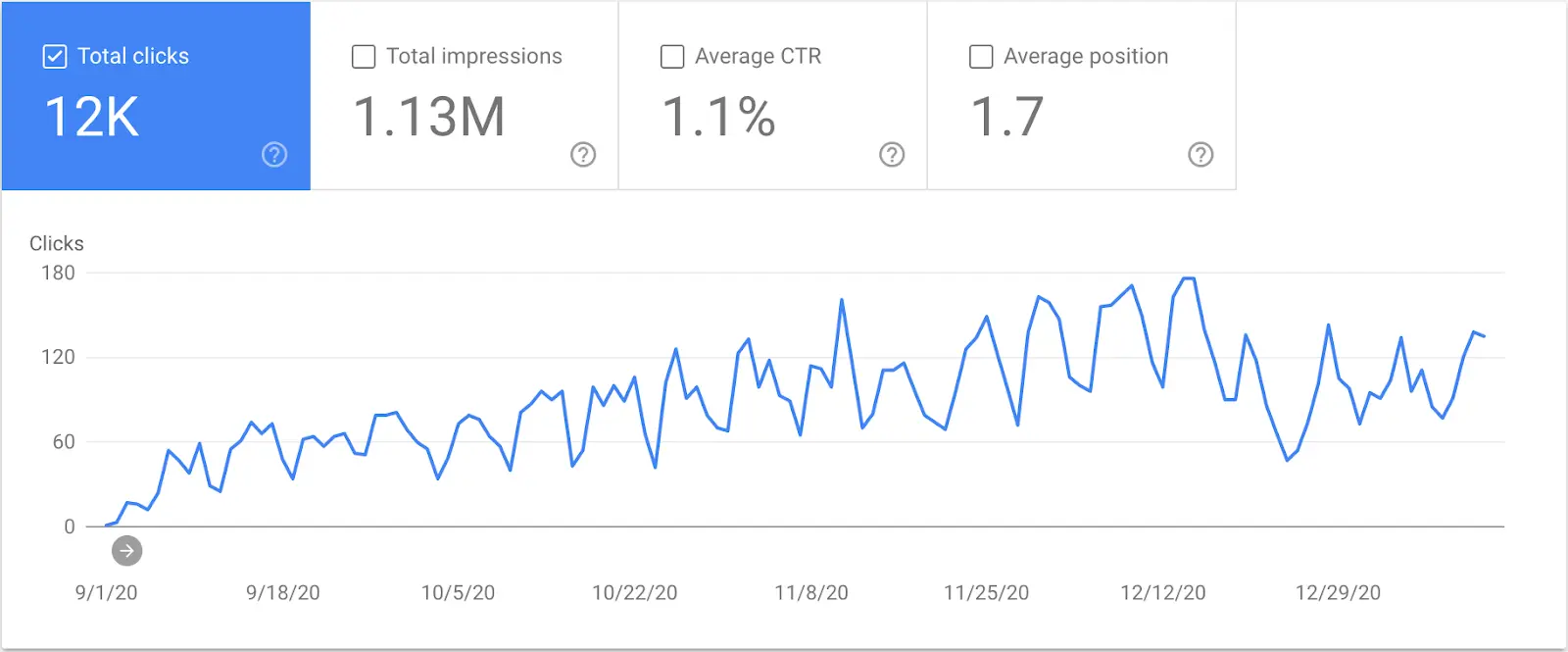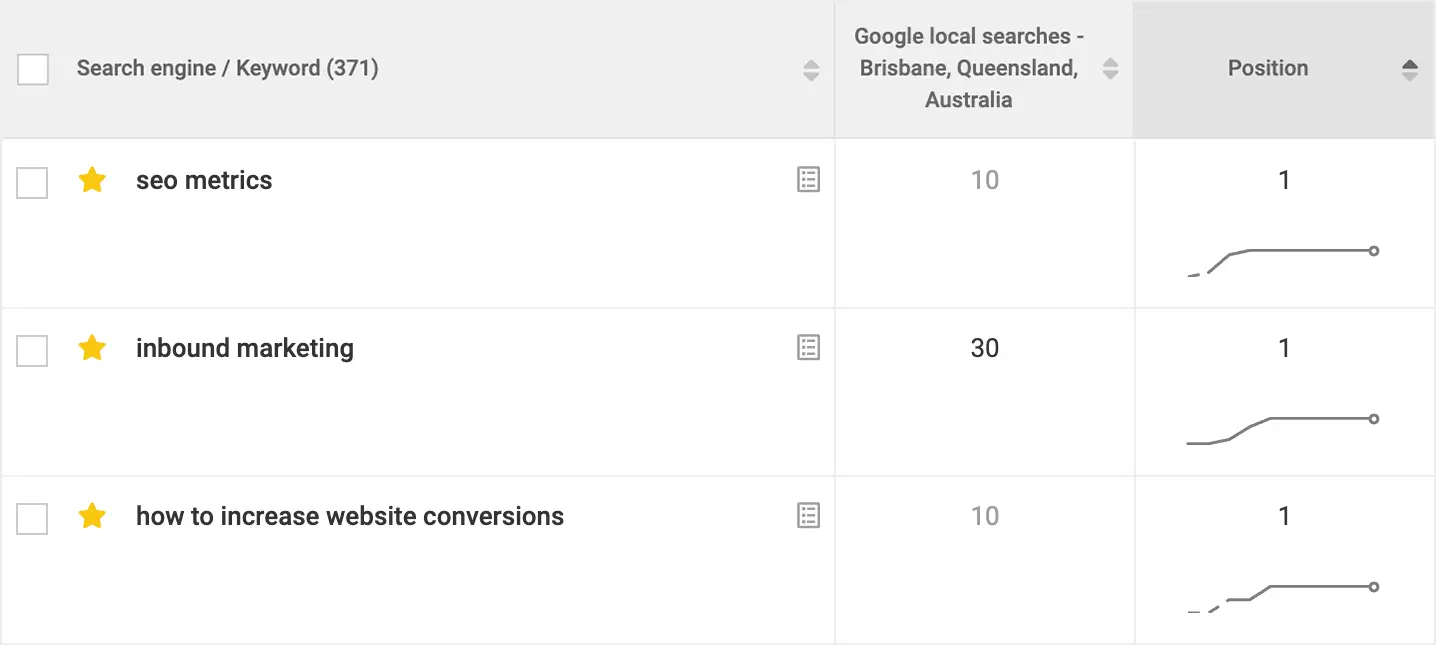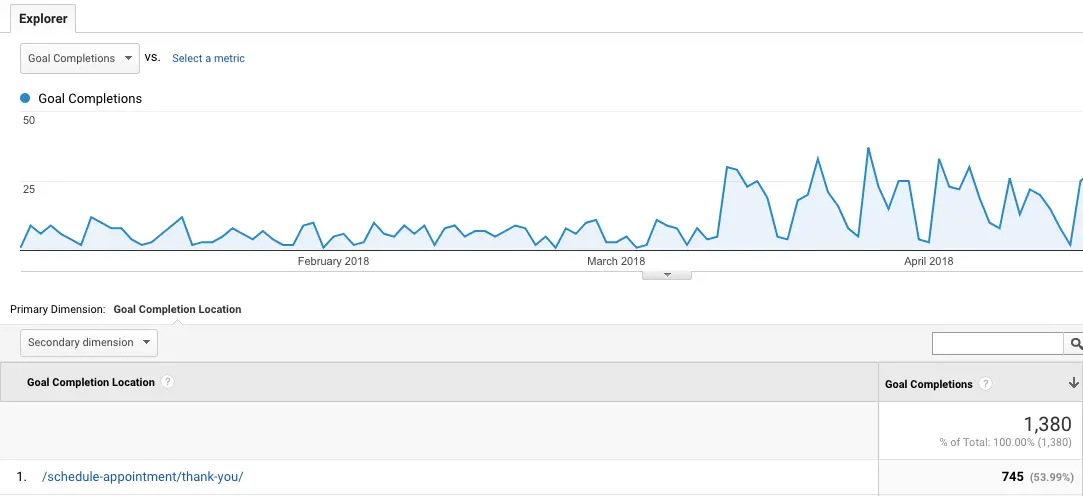4 Crucially Important SEO Metrics To Track [Guide]
With around six billion web pages jostling for attention,1 making your website more visible remains one of the most important marketing tasks you can do for your business, and it’s achieved primarily through good SEO.
But when it comes to measuring the success of your SEO, with so many tools and so many metrics, you can be forgiven for being confused. It’s easy to get lost in a world of bounce rates, pageviews, and backlinks, losing sight of the metrics that actually matter to your bottom line.
In this article, we’ll explore the most important SEO metrics for your business, so that you can truly understand how well your website is performing, and what you need to do to make your business more visible in Google.
Why measure SEO performance metrics?
Your website is arguably the most important marketing tool in your arsenal. It should be modern, beautiful, and usable, with content that answers the user’s most pressing questions about your services or products. Websites that match this description tend to rank well in Google, and have killer SEO performance metrics.
But due to the technical nature of SEO, it’s essential to focus on the right metrics, so you can assess the performance of your website, rather than simply hoping the results will come. By measuring the SEO metrics of your website, you can get a clearer picture of its strengths and weaknesses, and focus your efforts on the tasks that provide the biggest rewards.
In essence, effective SEO measurement informs your business decisions, allowing you to create a potent strategy for your website that will generate more leads, more conversions, and more revenue.
Important SEO metric types
Before we jump into the most important SEO metrics, it’s important to understand the different types that are available, so that we can better understand why we’re measuring them.
Lead and lag SEO metrics
Lead and lag metrics help you to understand your past and future performance
When viewed as a snapshot, metrics aren’t always instructive. Plucking a single metric from a single point in time tells you nothing about what has happened in the past, which stifles your ability to predict the future. To determine where an SEO campaign is succeeding or failing, a wider scope of data is needed, which allows you to identify trends. And the best way to identify trends is with lead and lag metrics.
Lead SEO metrics are about the future. They’re psychics who can provide you with the ability to look forward and predict what is likely to happen, “leading” you to effective decisions. They also tell you if you are likely to achieve your goals. An example of a valuable lead metric are “impressions,” which is one of our key SEO metrics (more below).
Lag SEO metrics are about the past. They’re historians who reveal what has already happened, and whether you have achieved your goals. An example of a lag metric would be clicks, or goal conversions (again, more on these below).
By using these two types of metrics in combination, you have a much clearer picture of how your website is performing at different stages of your SEO campaign, and what is likely to happen in the future. This lets you know whether to be patient and wait for results, or change your approach.
SEO performance metrics and SEO diagnostic metrics
Performance and diagnostic metrics are another label (or type) given to metrics that can help us to understand what they mean, and improve our decision-making.
SEO performance metrics measure how your business is performing, using critical data such as goal conversions, keyword rankings, and ROI. A KPI (key performance indicator) is a common example of a performance metric. SEO performance metrics are incredibly important.
SEO diagnostic metrics help to identify problems with a business, which can then be fixed. They’re an indicator of health.
SEO success is often measured using diagnostic metrics such as bounce rates, page speeds, and toxic backlinks, which can be useful, but tell you little about what has happened in the past, or what is likely to happen in the future. To emerge from the haze, we need to focus on performance metrics, and then use diagnostic metrics to understand the performance and what we can do to improve.
How do these different SEO metrics fit into the whole picture?
To get the best insights for your business, it’s important to understand performance vs diagnostic metrics, as well as lead vs lag metrics. With this knowledge, you can really start to understand what different metrics mean and when to use them to make decisions.
Common SEO metric types
The matrix below provides a simplistic breakdown of where some common SEO metrics fit.
| Lead | Lag | |
| Performance | ImpressionsPage 2-10 organic rankings
Organic CTR GMB reviews |
Organic trafficOrganic goal conversions
Page 1 organic rankings Page 1 GMB rankings GMB goal conversions |
| Diagnostic | Page speedInbound links
Technical errors Landing page scores Crawl errors |
Average time on siteBounce rate
Pages per visit Domain authority |
Here is how the metric “categories” are commonly used:
- SEO performance lag metrics: These are the most important metrics because they help to measure your return on investment. However, they shouldn’t be the focus too early in an SEO campaign, and they also need to be tracked as trends, rather than as a snapshot.
- SEO performance lead metrics: These metrics help you to predict future results. They can’t be tied directly to return on investment, but are super important to know if your SEO is on the right track.
- SEO diagnostic lag metrics: These metrics are often a snapshot. They provide insight into what may be contributing to the performance lag metrics, but rarely provide enough detail on what actions should be taken. They can take several months to change, so also shouldn’t be checked frequently. They often include measures of user engagement and overall authority of the website.
- SEO diagnostic lead metrics: This group of metrics are often fairly granular, and a focus point for SEO campaigns. They provide levers of influence on the website performance and are extremely useful to understand and measure SEO performance. If these metrics can achieve or exceed their targets, this helps to create SEO advantages and allows us to eliminate possible barriers to performance.
The most important SEO metrics to measure
These are the SEO performance metrics that enable you to measure the success of your SEO, make informed business decisions to improve it, and increase the number of leads and sales on your website. They should also be used to measure SEO performance on a monthly basis, and compared to monthly and annual trends.
1. Organic impressions
Organic impressions are our first metric, and the most important performance lead metric that can be used to measure SEO performance. They show us how many times a web page has appeared in Google’s search results. This doesn’t necessarily mean that the user has seen your page’s result in Google (or that they’ve even scrolled into its view), just that it has appeared for them as part of their search.
Without impressions, people aren’t able to find your website in Google. For this reason, impressions are a lead SEO metric that tell you whether you’re likely to achieve your business goals. The more impressions you have, the more likely you are to generate clicks that turn into leads and sales.
In order to measure SEO performance, rather than looking at impressions for individual pages, we would look at impressions for the whole website. Impressions that are increasing, decreasing, or remaining stable provide us with early signals for the future. In the initial phases of a new SEO campaign, they are one of the most important SEO metrics to track , but as the campaign matures, it tends to be something to check periodically or when we make substantial changes to the campaign. To break impressions down further, we can also group them by keyword type (informational or transactional) or by page, but this depends on what you’re trying to understand.
Impressions for keywords can be viewed in Google Search Console, which are labelled as “queries.” You can see exactly how many impressions each keyword has, and whether they are trending upwards, downwards, or remaining stable.
Impressions in Google Search Console
This data becomes available the day after setting up Google Search Console for your site.
2. Clicks (organic visitors)
When an impression/search result is relevant to the user’s search query and uses text that clearly describes what they’re looking for, the result may be a click (also known as an organic visitor). Clicks are an SEO performance lag metric that tells you whether you’re achieving the goal of bringing people to your site.
Click success is influenced by the following:
- The page’s ranking/position in the search results
- How relevant the page is to the user’s search
- How relevant the page’s title is to the user’s search
- How enticing the page title is (does it persuade the user to click?)
If your clicks are trending upwards, you may be satisfying any or all of the above factors. If they’re not, you should investigate each factor to determine where you might be going wrong.
Clicks can be used in combination with impressions to identify your click-through rate (CTR), which is calculated by dividing impressions by clicks. If one of your pages has a low CTR, you might consider improving its title to make it more enticing and relevant. But to be clear, CTR isn’t a key performance metric that describes the state of our SEO, but a diagnostic metric that reveals a problem with your page titles (if you’d like to boost this stat, check out our article on How To Improve Your CTR).
As with impressions, clicks are available through Google Search Console. They can also be analysed in greater detail using Google Analytics, and are one of the most important SEO metrics to track for your website.
Clicks in Google Search Console
3. Organic keyword rankings
Organic keyword rankings are another key SEO metric that can be used to measure the performance of a website. Every business should know which keywords bring profitable visitors to their site. If a keyword phrase leads prospects to a page that generates revenue for your business, you should be targeting it. Organic keyword rankings can be broken down into several categories, but in the first instance, we want to see if the overall organic rankings are trending up or down. In the early phases of an SEO campaign, we would measure results in the first 10 pages on Google, but as a campaign matures, we focus on positions 1-10 on the first page and then on potential keywords on pages 2 and 3.
We generally start by measuring “transactional keywords,” which are keywords used by people with a high intention to purchase. These are grouped and targeted on the core service pages of a website (e.g. “SEO Services Brisbane”). These are the most important keywords, as they generate almost all of the leads.
The other type of keyword is “informational.” These are keywords associated with educational content on your website (such as blogs), created to enhance your brand’s authority, and to drive up the rankings for your transactional keywords. This is often where a website can generate the majority of the impressions and clicks, and is critical to boost user signals to Google about the importance of a website.
For measuring SEO success, we should focus on the rankings of our transactional keywords, as they lead directly to revenue (rather than just influencing it). As a predictor of success, transactional keyword rankings in pages 2-10 are a lead metric, but page 1 rankings are more of a performance lag metric, as they tend to drive leads and sales.
Keyword rankings are influenced by every SEO variable, including:
- Whether your website’s content is relevant to the keywords being searched, and optimised for them (there’s a clear link between SEO and effective content marketing)
- Your website’s code (whether it uses modern coding practices favoured by Google)
- Your website’s usability, especially for mobile
- How secure your website is, and whether it uses HTTPS protocols
- Your website’s authority
- The number of backlinks that your website has, and their quality
Transactional keyword rankings can be tracked and measured using a variety of auditing tools, which allow you to identify trends over time. It’s also important to note that when you start targeting and optimising for a new transactional keyword, it can take between four to six months before you start ranking in Google’s top three SERPs (search engine results pages). SEO is all about earning your way to the top, so it’s critical to be patient, and remember the potential for high return on investment.
Keyword rankings
Because transactional keyword rankings are affected by so many things, it can be challenging to improve them. Each influencing factor must be analysed individually, and improved where possible. This requires the use of various tools (e.g. WebCEO, Google Analytics, SEMrush, Atom) and skill sets (data analysis, SEO optimisation, web development), depending on the factor being tackled.
4. Goal conversions
Goal conversions are the final piece of the puzzle, and might be considered the most important SEO metric—the ultimate measure of your SEO success. After all, without enquiries forms being completed, phone calls being received, or products being purchased, there’s no point in measuring SEO performance at all!
The goals that you set for your website will depend on your type of business. If you’re a service-based business, you’ll want your visitors to submit your contact form (or another type of enquiry form), and perhaps call your company’s telephone number directly from the website. If you’re a product-based business, you’ll want people to add items to their cart, and then purchase them. Goal conversions are a performance lag metric, because they measure whether you’re achieving the primary, revenue-generating goals for your website.
Goal conversions for service and product-based websites tend to be influenced by the following:
- Your value proposition—is it attractive and competitive?
- The usefulness of your site’s content, and whether you’re providing the user with the content they need
- The usability of your website, particularly how easy it is to submit enquiries and purchase products
- The beauty of your website (well-designed websites tend to convert better).
Goal conversions can be measured through Google Analytics, as well as CRM tools such as Hubspot. These powerful tools also allow you to measure assisted goal conversions, which allow you to track other important actions such as clicks and page visits before the final goal is completed.
Goal conversions in Google Analytics
If your goal conversions are trending downwards, their influential factors are addressed in a design approach called conversion-centred design, which uses design and content techniques to improve a website’s goal conversions. By better understanding this approach and adopting some of its principles, you can improve goal conversions across your website.
Important SEO metrics—summary
To summarise, the key SEO metrics to track and measure are impressions, clicks, keyword rankings, and goal conversions. There’s nothing wrong with the occasional look at other metrics such as page views, bounce rates, and backlinks—they can help to build a clearer picture of what’s happening in your business. But because our key SEO metrics are directly tied to your ability to generate revenue, they deserve the lion’s share of your attention.
By regularly analysing the trends for your impressions, clicks, keyword rankings, and goal conversions, you can better identify where you’re succeeding and failing, and make changes that will drive up the revenue for your business. At the end of the day, if you’re producing relevant, valuable content for your customers, and have a modern, well-designed website that meets Google’s key priorities (such as their Core Web Vitals), you’ll all set.
References
2020, How Many Websites Are There? (Updated for 2020), Websitesetup.org
Thanks for reading our article on important SEO metrics! If you’d like to know more about measuring your digital marketing performance, check out our comprehensive guide to Every Digital Marketing Metric You Need for your business.







